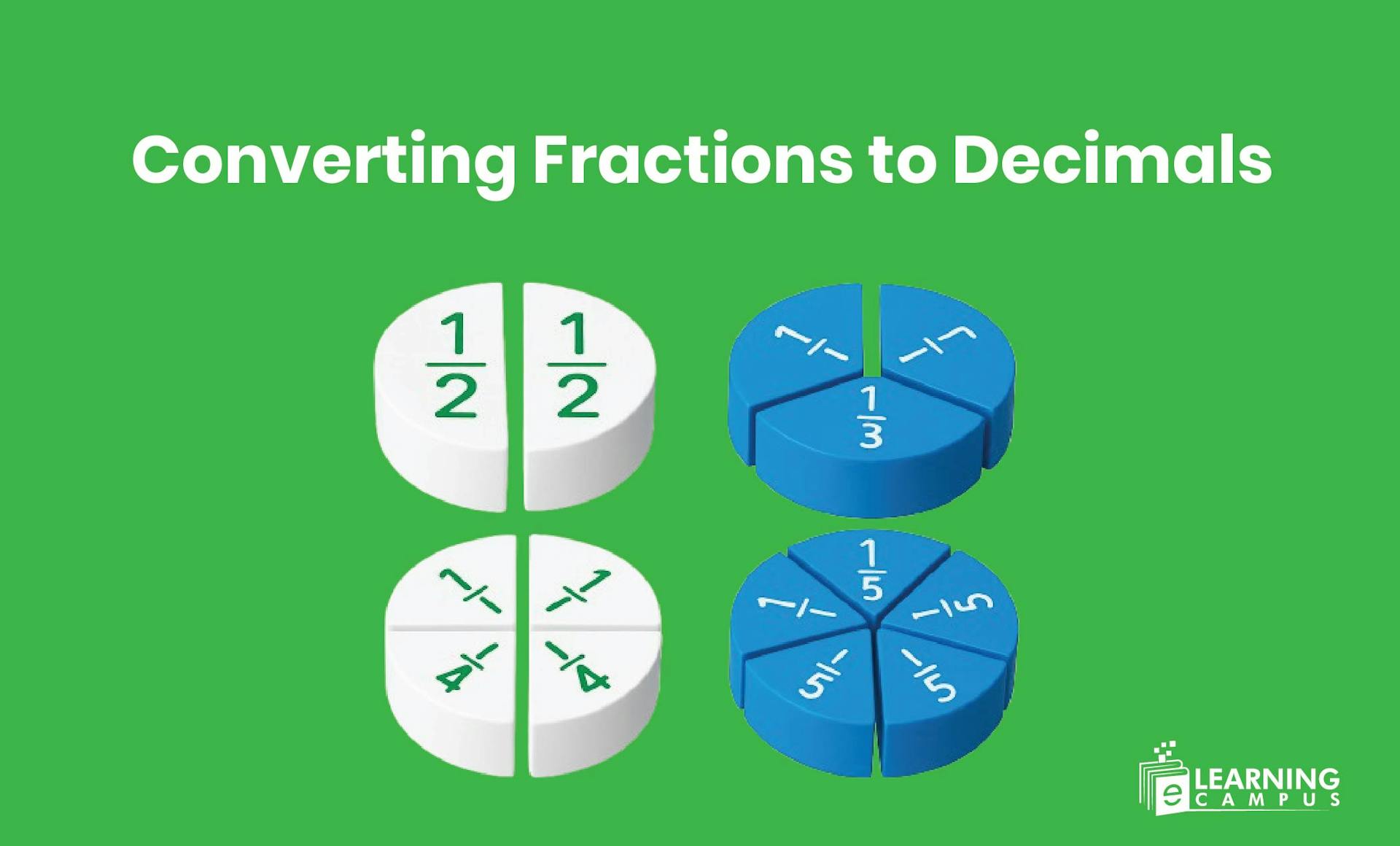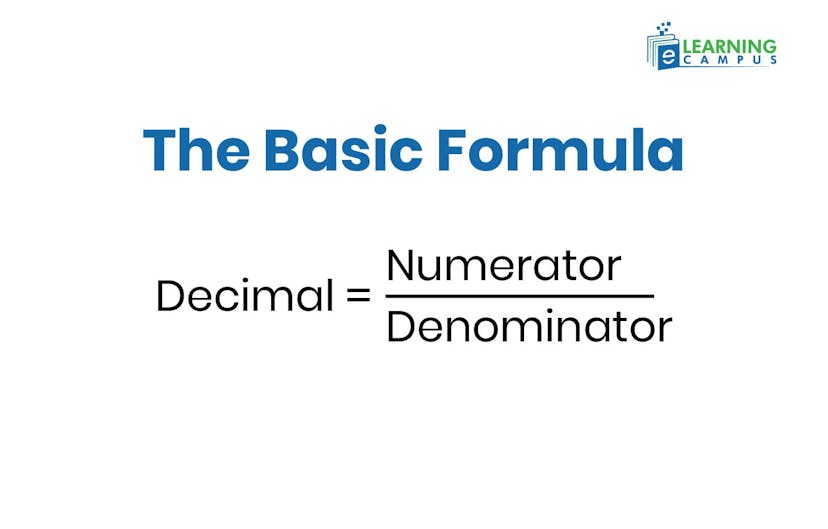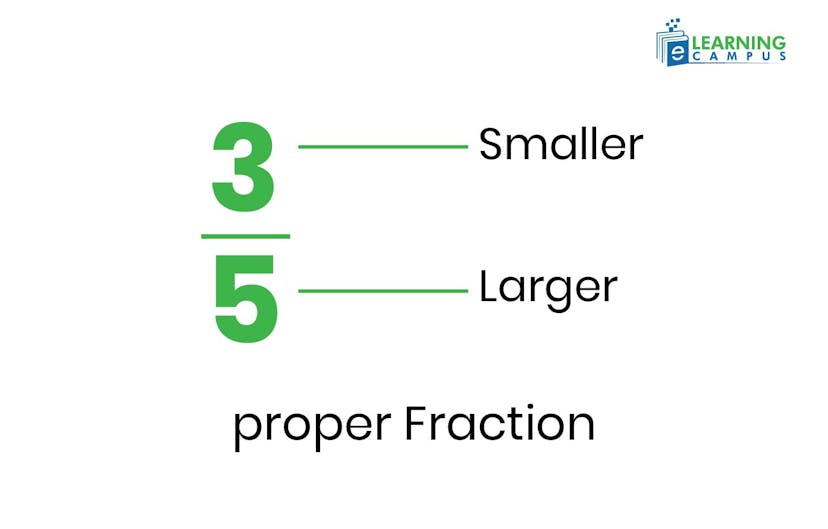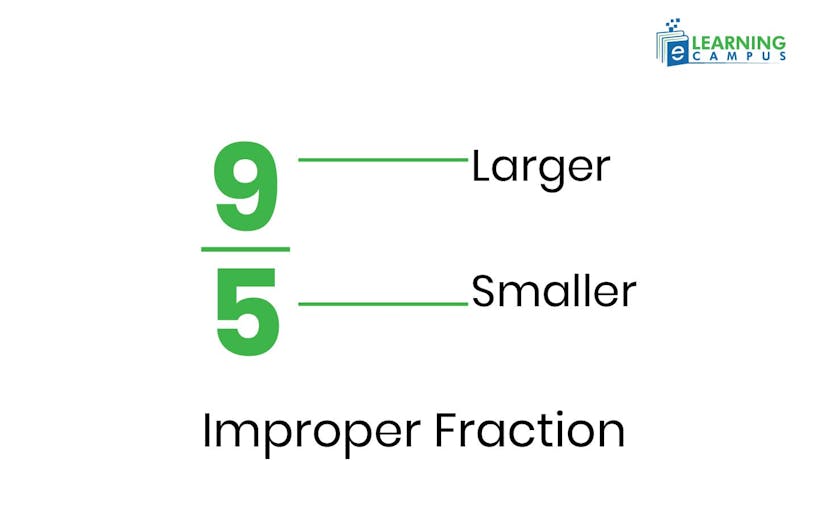Converting Fractions to Decimals - Learn Fast with Easy Formulas & Conversion Chart

Have you ever wondered why some fractions like 1/2 or 3/4 are so easy to understand but others like 7/22 or 3 3/8 feel confusing to convert? Studies show that over 60% of students struggle with fraction-to-decimal conversion, even though it’s one of the most useful math skills in daily life.
This blog will make converting fractions to decimals simple, from basic fractions to mixed numbers, terminating decimal and recurring decimals. It includes decimal worksheets, practice charts and conversion formulas so you can easily understand how to convert fractions into decimals.
Understanding Fractions and Decimals
Fractions and decimals can appear different, yet they display the same concept - parts of a whole. Knowing one makes calculations easier and more applicable in everyday life. When you understand their relationship, it is easy and fast to convert fractions to decimals.
What Is a Fraction?
A fraction shows how many parts of a whole you have. It has two numbers (1) the numerator (the top number) and (2) the denominator (the bottom number).
- Numerator tells how many parts are taken.
- Denominator tells how many total parts the whole is divided into.
Examples:
- 1/2 means 1 part out of 2
- 3/4 means 3 parts out of 4
- 2/3 means 2 parts out of 3
We use fractions in real life all the time like cutting a pizza in half (1/2), measuring ingredients (3/4 cup) or dividing time.
Learn:
What Is a Decimal Number?
A decimal number uses a decimal point (.) to show parts of a whole. It’s another way to write a fraction. The number to the right of the decimal point shows the fractional part.

Examples:
- 0.25
- 0.5
- 0.75
- 3.142 (approximation of π)
Decimals are often used in money, measurements and percentages because they’re fast and easy to read.
Why Learn Fraction-to-Decimal Conversion?
Learning fraction-to-decimal conversion is important because we use both forms every day in school, shopping, cooking and even construction. It helps make numbers easier to compare, calculate, and use.
Real-Life Examples:
- Converting a recipe from 1/2 cup to 0.5 cup
- Calculating discounts in shopping
- Measuring materials in decimals for accuracy
Knowing how to switch between fractions and decimals makes math faster, clearer and more practical.
How to Convert Fractions into Decimals
Converting fractions to decimals becomes simple once you learn the basic rule. Just divide the numerator (top number) by the denominator (bottom number). Below are clear examples to help you understand each type of fraction easily.
The Basic Formula
To convert a fraction into a decimal:

Example:
3 ÷ 4 = 0.75
So, 3/4 = 0.75
Converting Proper Fractions
Proper fractions are those where the numerator is smaller than the denominator. When you divide, the answer will always be less than 1.

Examples:
- 1/6 as a decimal
Solution:
Step 1: Write it as a division
A fraction means division.
So, 1 ÷ 6
Step 2: Set up the long division
We’ll divide 1 by 6 like this
0.1666...
______________
6 | 1.000000000
- 0.6
----
40
-36
--
40
-36
--
40
Step 3: Divide step by step
- 6 doesn’t go into 1, so put 0. and make it 10
- 6 × 1 = 6 → subtract → remainder 4
- Bring down a 0, now we have 40
- 6 × 6 = 36 → subtract → remainder 4 again
- It keeps repeating!
Step 4: Final Answer
1 ÷ 6 = 0.1666... = 0.16̅
- 5/16 into a decimal
Solution:
Step 1: Write it as a division
A fraction means numerator ÷ denominator. So, 5 ÷ 16
Step 2: Set up the long division
0.3125
__________
16 | 5.0000
- 4.8 (16 × 0.3 = 4.8)
----
20
- 16 (16 × 1 = 16)
----
40
- 32 (16 × 2 = 32)
----
80
- 80 (16 × 5 = 80)
----
0
Step 3: Divide step by step
- 16 goes into 50 three times → remainder 2
- Bring down 0 → now 20 → 16 × 1 = 16 → remainder 4
- Bring down 0 → now 40 → 16 × 2 = 32 → remainder 8
- Bring down 0 → now 80 → 16 × 5 = 80 → remainder 0
Step 4: Final Answer
5 ÷ 16 = 0.3125 (Proper and Terminating Fraction)
- 7/16 as a decimal
Solution:
Step 1: Write it as a division
7 ÷ 16
Step 2: Now divide
0.4375
__________
16 | 7.0000
- 6.4 (16 × 0.4 = 6.4)
----
60
- 48 (16 × 3 = 48)
----
120
- 112 (16 × 7 = 112)
----
80
- 80 (16 × 5 = 80)
----
0
Step 3: Divide step by step
- 16 goes into 70 four times → remainder 6
- Bring down 0 → now 60 → 16 × 3 = 48 → remainder 12
- Bring down 0 → now 120 → 16 × 7 = 112 → remainder 8
- Bring down 0 → now 80 → 16 × 5 = 80 → remainder 0
Step 4: Final Answer
7/16 = 0.4375
- Convert 1/16 to a decimal
Solution:
Step 1: Write it as a division
A fraction means numerator ÷ denominator. So, 1 ÷ 16
Step 2: Set up the long division
0.0625
__________
16 | 1.0000
- 0.96 (16 × 0.06 = 0.96)
----
0.040
- 0.032 (16 × 0.002 = 0.032)
----
0.008
- 0.008 (16 × 0.0005 = 0.008)
----
0
Step 3: Divide step by step
- 16 goes into 100 six times → remainder 4
- Bring down 0 → now 40 → 16 × 2 = 32 → remainder 8
- Bring down 0 → now 80 → 16 × 5 = 80 → remainder 0
Step 4: Final Answer
1 ÷ 16 = 0.0625
- 3/8 into a decimal
Solution:
Step 1: Write it as a division
A fraction means numerator ÷ denominator. So, 3 ÷ 8
Step 2: Set up the long division
0.375
__________
8 | 3.000
- 2.4 (8 × 0.3 = 2.4)
----
60
- 56 (8 × 7 = 56)
----
40
- 40 (8 × 5 = 40)
----
0
Step 3: Divide step by step
- 8 goes into 30 three times → remainder 6
- Bring down 0, now 60 → 8 × 7 = 56 → remainder 4
- Bring down 0, now 40 → 8 × 5 = 40 → remainder 0
Step 4: Final Answer
3 ÷ 8 = 0.375
- 9/16 into a decimal
Step 1: Write as division
9 ÷ 16
Step 2: Set up the long division
0.5625
________
16 | 9.0000
- 8.0 (16 × 0.5 = 8)
----
10
- 9.6 (16 × 0.6 = 9.6)
----
40
- 32 (16 × 0.2 = 32)
----
80
- 80 (16 × 0.5 = 80)
----
0
Step 3: Divide step by step
- 16 into 9 → 0, remainder 9 (write 0.).
- Bring down 0 → 90. 16 × 5 = 80 → write 5 → remainder 10.
- Bring down 0 → 100. 16 × 6 = 96 → write 6 → remainder 4.
- Bring down 0 → 40. 16 × 2 = 32 → write 2 → remainder 8.
- Bring down 0 → 80. 16 × 5 = 80 → write 5 → remainder 0 (stop).
Step 4: Final Answer
9/16 = 0.5625 (Proper & Terminating)
Converting Improper Fractions
Improper fractions have numerators larger than denominators, giving results greater than 1 when converted.

Examples:
- 3/2 as a decimal
Solution:
Step 1: Write it as a division
A fraction means numerator ÷ denominator. So, 3 ÷ 2
Step 2: Set up the long division
1.5
_______
2 | 3.0
- 2.0 (2 × 1 = 2)
---
10
- 10 (2 × 5 = 10)
---
0
Step 3: Divide step by step
- 2 goes into 3 one time → remainder 1
- Bring down a 0 to make it 10
- 2 × 5 = 10 → remainder 0
Step 4: Final Answer
3 ÷ 2 = 1.5
3/2 is an improper fraction that gives a terminating decimal (1.5)
- Decimal for 4/3
Solution:
Step 1: Write it as a division
4÷3
Step 2: Set up the long division
1.333...
__________
3 | 4.000000
- 3 (3 × 1 = 3)
----
10
- 9 (3 × 3 = 9)
----
10
Step 3: Divide Step by Step
- 3 into 4 → 1, remainder 1 (write 1.).
- Bring down 0 → 10. 3 × 3 = 9, remainder 1.
- Bring down another 0 → 10 again. 3 × 3 = 9, remainder 1.
- This pattern continues as 1.3333…
Step 4: Final Answer
4 ÷ 3 = 1.333...
- 5/2 as a decimal
Solution:
Step 1: Write it as a division
A fraction means numerator ÷ denominator. So, 5 ÷ 2
Step 2: Set up the long division
2.5
______
2 | 5.0
- 4 (2 × 2 = 4)
----
10
- 10 (2 × 5 = 10)
----
0
Step 3: Divide step by step
- 2 goes into 5 two times, remainder 1
- Bring down 0, now it’s 10
- 2 goes into 10 five times, remainder 0
Step 4: Final Answer
5 ÷ 2 = 2.5
6/5 as a decimal
Step 1: Write as division
6 ÷ 5
Step 2: Set up the long division
1.2
______
5 | 6.0
- 5.0 (5 × 1 = 5)
-----
10
- 10 (5 × 2 = 10)
-----
0
Step 3: Divide step by step
- 5 goes into 6 → 1 time, remainder 1
- Bring down 0 → 10 ÷ 5 = 2, remainder 0
Step 3: Final Answer
6/5 = 1.2 (Improper & Terminating)
Converting Mixed Numbers (Whole + Fraction)
To convert mixed numbers:
Step 1: Convert the fraction part into a decimal.
Step 2: Add it to the whole number.

Examples:
- 3 2/3 in decimal form
Solution:
Step 1: Change the mixed number to an improper fraction
3 2/3 = (3×3) + 2 / 3 = 11/3
Step 2: Divide using long division
3.666...
_________
3 | 11.000
- 9 (3 × 3 = 9)
----
20
- 18 (3 × 6 = 18)
----
20
- 18
----
20 → keeps repeating
Step 3: Divide step by step
- 3 × 3 = 9 → remainder 2
- Bring down 0 → 20 ÷ 3 = 6, remainder 2 (repeats)
Step 4: Final Answer
So, 3 and 2/3 as a decimal = 3.666... or 3.6̅
It’s a repeating decimal because the same digit (6) goes on infinitely.
- 3 3/4 as a decimal
Solution:
Step 1: Convert to improper fraction
3 3/4 = 15/4
Step 2: Write as division
15÷4
Step 3: Long division
3.75
_______
4 | 15.00
- 12
--
30
- 28
--
20
- 20
--
0
Step 3: Divide step by step
- 4 × 3 = 12 → remainder 3
- Bring down 0 → 30 ÷ 4 = 7, remainder 2
- Bring down 0 → 20 ÷ 4 = 5, remainder 0
Step 4: Final Answer
3 3/4 = 3.75
- 3 3/8 as a decimal
Solution:
Step 1: Convert to improper fraction
3 3/8 = 27/8
Step 2: Write as division
27÷8
Step 3: Long division
3.375
_______
8 | 27.000
- 24
--
30
- 24
--
60
- 56
--
40
- 40
--
0
Step 3: Divide step by step
- 8 × 3 = 24 → remainder 3
- Bring down 0 → 30 ÷ 8 = 3, remainder 6
- Bring down 0 → 60 ÷ 8 = 7, remainder 4
- Bring down 0 → 40 ÷ 8 = 5, remainder 0
Step 3: Final Answer
3 3/8 in decimal = 3.375 ( terminating decimal)
- 2 5/8 as a decimal
Solution:
Step 1: Convert to improper fraction
2 5/8 = (2×8 + 5)/8 = 21/8
Step 2: Write as division
21 ÷ 8
Step 3: Long division
2.625
______
8 | 21.000
- 16
---
50
- 48
---
20
- 16
---
40
- 40
---
0
Step 3: Divide step by step
- 8 × 2 = 16 → remainder 5
- Bring down 0 → 50 ÷ 8 = 6, remainder 2
- Bring down 0 → 20 ÷ 8 = 2, remainder 4
- Bring down 0 → 40 ÷ 8 = 5, remainder 0
Step 4: Final Answer
21 ÷ 8 = 2.625
Using Long Division for Complex Fractions
For fractions that don’t divide evenly, use long division to get repeating or non-terminating decimals.
Example: Which is the decimal expansion of 7/22?
0.3181...
______________
22 | 7.000000000
- 66 ← (22 × 3 = 66)
----
40
- 22 ← (22 × 1 = 22)
----
180
- 176 ← (22 × 8 = 176)
----
4
Now we’re back to the same remainder (4) we had earlier, so the digits 3181 will keep repeating.
Therefore, 7 ÷ 22 = 0.31818181… or simply 0.318̅ (the bar means the digits 18 repeat endlessly).
Common Fractions and Their Decimal Equivalents
Here’s a quick reference fraction decimal chart to help you remember common fractions and their decimal forms. These conversions make solving math problems, percentages and measurements much easier.
Fraction Decimal Chart
Decimal for Mixed Fractions
To convert a mixed fraction into a decimal, first divide the fractional part and then add it to the whole number.
Examples:
- 3 1/3 as a decimal = 3 1/3 → Fraction part = 1 ÷ 3 = 0.333… → 3 + 0.333 = 3.333…
- 2 2/3 in decimal form = 2 2/3 → Fraction part = 2 ÷ 3 = 0.666… → 2 + 0.666 = 2.666…
- 7 7/8 as a decimal= 7 7/8 → Fraction part = 7 ÷ 8 = 0.875 → 7 + 0.875 = 7.875
Special Types of Decimals
Decimals can appear in different forms depending on how the division between the numerator and denominator works. Let’s look at the three main types: terminating, recurring and non-terminating decimals with simple examples.
Terminating Decimal
A terminating decimal is a decimal number that stops after a certain number of digits and does not repeat.
Examples:
- 1/2 as a decimal
Solution:
Step 1: Write it as a division
A fraction means division. So, 1 ÷ 2
Step 2: Set up the long division
We’ll divide 1 by 2 like this
0.5
________
2 | 1.0
- 1.0
---
0
Step 3: Divide step by step
- 2 doesn’t go into 1, so we write 0. and make it 10
- 2 × 5 = 10 → subtract → remainder 0
- No remainder means the division ends here.
Step 4: Final Answer
1 ÷ 2 = 0.5
It’s a terminating decimal because the division ends with no remainder.
- What is a 1/4 as a decimal?
Solution:
Step 1: Write it as a division
A fraction means we divide the top number (numerator) by the bottom number (denominator).
So, 1 ÷ 4
Step 2: Set up the long division
0.25
_________
4 | 1.00
- 0.8 (4 × 0.2 = 0.8)
----
0.20
- 0.20 (4 × 0.05 = 0.20)
----
0
Step 3: Final Answer
1 ÷ 4 = 0.25
- What is 3/5 as a decimal
Solution:
Step 1: Write it as a division
A fraction means numerator ÷ denominator. So, 3 ÷ 5
Step 2: Set up the long division
0.6
_______
5 | 3.0
- 3.0 (5 × 6 = 30)
---
0
Step 3: Divide step by step
- 5 goes into 3 → 0, remainder 3
- Add 0 → 30 ÷ 5 = 6, remainder 0
Step 3: Final Answer
3 ÷ 5 = 0.6
- 4/5 as a decimal
Solution:
Let’s convert 4/5 into a decimal step by step:
Step 1: Write the formula
Decimal = Denominator / Numerator
Step 2: Divide
0.8
_______
5 | 4.0
- 4.0 (5 × 0.8 = 4.0)
---
0
Step 3: Final Answer
4 ÷ 5 = 0.8
- 2 1/2 as a decimal
Solution:
Step 1: Change to improper fraction
2 1/2 = 5/2
Step 2: Write as division
5÷2
Step 3: Long division
2.5
______
2 | 5.0
- 4
--
10
-10
--
0
Step 3: Final Answer
2 1/2 = 2.5
- 3/5 as a decimal
Solution:
Step 1: Write as division
3 ÷ 5
Step 2: Set up long division
0.6
______
5 | 3.0
- 3.0 (5 × 0.6 = 3.0)
-----
0
Step 3: Final Answer
3 ÷ 5 = 0.6
Non-Terminating Decimals
A non-terminating decimal is a decimal number with an infinite number of digits after the decimal point. But there are two types of non-terminating decimals:
- Repeating (Recurring):
The digits repeat in a pattern.
Example: 1/9 = 0.111... → the 1s keep repeating.
- Non-repeating (Irrational):
The digits go on forever without any pattern.
Example: π = 3.141592653... → the numbers never repeat in any pattern.
Examples:
- 1/9 as a decimal
Solution:
Step 1: Write it as a division
A fraction means numerator ÷ denominator. So, 1 ÷ 9
Step 2: Set up the long division
0.111...
__________
9 | 1.000000
- 0.9 (9 × 0.1 = 0.9)
----
10
- 9 (9 × 1 = 9)
----
10
- 9
----
10
..…and it keeps repeating the same pattern.
Step 3: Divide step by step
- 9 goes into 10 one time → remainder 1
- Bring down 0 → still 10 → 9 × 1 = 9 → remainder 1
- This repeats again and again...
Step 4: Final Answer
1 ÷ 9 = 0.111...
It’s a proper and non-terminating (repeating) decimal.
- 1/12 as a decimal
Solution:
Step 1: Write it as a division
1÷12
Step 2: Set up long division
0.0833…
__________
12 | 1.00000
- 0.96 (12 × 0.08 = 0.96)
----
0.040
- 0.036 (12 × 0.003 = 0.036)
----
0.004 → continues repeating 3
Step 3: Final Answer
1/12 = 0.0833… (repeating) non-terminating repeating decimal.
- 8/9 as a decimal
Solution:
Step 1: Write as division
8 ÷ 9
Step 2: Set up long division
0.888…
______
9 | 8.000
- 8.1 (9 × 0.8 = 7.2)
-----
8 (keeps repeating)
Step 3: Final Answer
8/9 = 0.888... (Non-Terminating, Repeating)
- 1 2/3 as a decimal
Solution:
Step 1: Convert to improper fraction
1 2/3 = (1×3 + 2)/3 = 5/3
Step 2: Write as division
5 ÷ 3
Step 3:Set up long division
1.666...
______
3 | 5.000
- 4.8
----
20
- 18
----
20 (repeats)
Step 4: Final Answer
5 ÷ 3 = 1.666...
- 2/7 as a decimal
Step 1: Write as division
2 ÷ 7
Step 2: Set up long division
0.285714...
______
7 | 2.000000
- 1.4
----
60
- 56
----
40
- 35
----
50
- 49
----
10
Step 3: Final Answer
2 ÷ 7 = 0.285714...
Decimal Operations (Practice Worksheets Section)
Once you understand converting fractions to decimals, the next step is to practice how decimals work in real calculations. This section includes simple worksheets and examples for adding, subtracting, multiplying, dividing and rounding decimals perfect for students who want extra practice.
Adding and Subtracting Decimals Worksheets
When adding or subtracting decimals, always line up the decimal points vertically. This ensures you’re working with the correct place values (tenths, hundredths, etc.).
Example:
4.75
+ 2.30
———
7.05
Tip: Add zeros if needed to make the decimal places equal before adding or subtracting.
Multiplying Decimals Worksheets
To multiply decimals:
- Ignore the decimal points and multiply normally.
- Count the total number of decimal places in both numbers.
- Place the decimal point in the answer accordingly.
Example:
2.5 × 1.6 = 25 × 16 = 400, then move the decimal two places → 4.00
Answer: 4.0
Dividing Decimals Worksheet
When dividing decimals:
- Move the decimal point in the divisor to make it a whole number.
- Move the decimal point in the dividend the same number of places.
- Divide as usual.
Example:
6.4 ÷ 0.8 → Move both decimals one place → 64 ÷ 8 = 8
Answer: 8
Quiz Practice: Try questions like
- 3.6 ÷ 0.9 = ?
- 4.2 ÷ 0.7 = ?
Rounding Decimals Worksheet
Rounding decimals helps simplify numbers for easier calculations.
Rules:
- If the next digit is 5 or more, round up.
- If it’s 4 or less, round down.
Examples:
4.76 → 4.8 (round up)
5.23 → 5.2 (round down)
Real-Life Applications of Decimal Conversion
Decimals are not just for math class - they’re everywhere in daily life! From measuring wood for furniture to calculating your shopping bill, knowing how to convert fractions to decimals helps you work faster and more accurately. Let’s explore where decimals make a difference.
In Measurement (Feet and Inches)
When working in construction or design, measurements often appear as fractions like 4 ½ feet or 3 ¾ inches. To make calculations easier, we use decimal conversions.
Example:
- ½ foot = 0.5 feet
- ¼ inch = 0.25 inches
- ¾ inch = 0.75 inches
Conversion Formula:
1 foot = 12 inches
So, multiply the decimal part by 12 to find inches.
Example:
5.25 feet × 12 = 63 inches
Learn: How to convert 8 Feet to Inches
In Coding and Prefix Systems
In programming, decimals are used to represent precise numeric values called decimal literals. For instance, writing 0.5, 3.14, or 10.0 in code ensures accuracy in calculations involving money, measurements, or percentages.
Example in Python:
price = 19.99
discount = 0.10
final_price = price - (price * discount)
print(final_price) # Output: 17.991
Tip: Understanding prefixes with decimals (like 0.0 or 1.0) helps programmers avoid rounding errors in financial or scientific calculations.
- <h3>In Finance and Daily Life
Decimals are a big part of our everyday routines whether you’re checking prices, splitting bills, or calculating discounts.
Examples:
- $2.50 = two and a half dollars
- 7.75% sales tax = 7¾ percent
- 0.5 liters = half a liter
Fraction-to-Decimal Conversion Tools
Learning fractions and decimals is much easier when you have fast tools ready. Below are online converters and printable charts you can use instantly or embed in your blog.
Online Calculators
Use these free converters to turn any fraction into a decimal instantly.
- RapidTables Fraction to Decimal Converter - simple and clean interface.
- Omni Calculator Fraction to Decimal Tool - handles more complex fractions too.
Hire Expert Math Tutors at eLearningCampus – Learn Smarter, Not Harder!
Hire a professional Math Tutor from eLearningCampus for clear explanations, real examples and personalized lessons that make math simple.